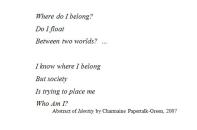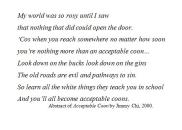AustLit
-
In contemporary Australia as well as pre-contact Australia there is no single right way or one way to be Aboriginal or Torres Strait Islander. Identities will vary according to place, time, language group and socio-historical context of the author.
This trail, created by Professor Anita Heiss, collects just a sample of BlackWords records and other internet resources with themes of identity in Indigenous culture. Explore the entries in the list to see the contents in more detail. Some of the resources are readily available, but some will require a visit to a library or bookshop.
-
Explore, Search, Discover
Find more BlackWords information by going to AustLit's Advanced Search form where you can limit your search results to the BlackWords project by selecting BlackWords in the 'Limit to AustLit Project' option, or search for authors with Aboriginal or Torres Strait Islander heritage by selecting cultural heritage under the 'Personal details' option.
-
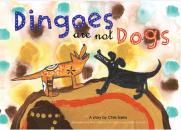 This image has been sourced from Anita Heiss 2014.See full AustLit entry
This image has been sourced from Anita Heiss 2014.See full AustLit entryDingoes Are Not Dogs is a story about recognising and appreciating difference, and about friendship and reconciliation.
(...more) -
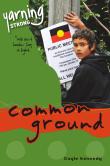 This image has been sourced from Anita Heiss 2014.See full AustLit entry
This image has been sourced from Anita Heiss 2014.See full AustLit entry'Maree, Zeke and J don't know what to expect when they visit their nan's traditional land to help with a land rights claim. And things get tougher than they ever could have imagined.' (Source: Booktopia website)
(...more) -
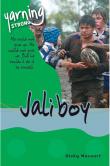 Image courtesy of publisher's website.See full AustLit entry
Image courtesy of publisher's website.See full AustLit entry'Being sent to boarding school in the city is harder than Jali could ever have imagined. But what no one yet knows, even Jali, is that this boy is a warrior at heart.' (Source: Publishers website)
(...more) -
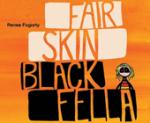 Courtesy of Magabala Books'This is the story of Mary, a young Aboriginal girl who lives on a red and dusty cattle station. Shunned by the other girls because of her fair skin, Old Ned, one of the community Elders, finally speaks up. With words of wisdom, he teaches the girls that Aboriginal identity transcends skin colour and that family, community, country, culture and spirituality is what being Aboriginal is really about.' Source: www.magabala.com (...more)See full AustLit entry
Courtesy of Magabala Books'This is the story of Mary, a young Aboriginal girl who lives on a red and dusty cattle station. Shunned by the other girls because of her fair skin, Old Ned, one of the community Elders, finally speaks up. With words of wisdom, he teaches the girls that Aboriginal identity transcends skin colour and that family, community, country, culture and spirituality is what being Aboriginal is really about.' Source: www.magabala.com (...more)See full AustLit entry -
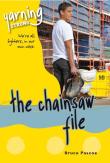 This image has been sourced from Anita Heiss 2014.'Suspended from school for arguing about Australian history with his teacher, Tyrone works on a building site with his dad and learns that there's more than one way to be a hero for his people.' (From the publisher's website.) (...more)See full AustLit entry
This image has been sourced from Anita Heiss 2014.'Suspended from school for arguing about Australian history with his teacher, Tyrone works on a building site with his dad and learns that there's more than one way to be a hero for his people.' (From the publisher's website.) (...more)See full AustLit entry -
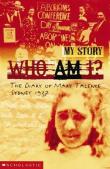 Cover image courtesy the Author.Mary was taken to Bomaderry Aboriginal Children's Home when she was only five years old. Now she's ten years old and living with a white family in Sydney. She doesn't fit in and starts to question why. We live Mary's emotional, psychological and physical journey through her twelve months of diary entries, explaining the collective story of the those members of the Stolen Generation removed under policies of Protection in NSW. The diary format helps to transport readers back through time to 1938 and the lead up to the Sesquintennary and the Day of Mourning Conference and protest in Sydney. (...more)See full AustLit entry
Cover image courtesy the Author.Mary was taken to Bomaderry Aboriginal Children's Home when she was only five years old. Now she's ten years old and living with a white family in Sydney. She doesn't fit in and starts to question why. We live Mary's emotional, psychological and physical journey through her twelve months of diary entries, explaining the collective story of the those members of the Stolen Generation removed under policies of Protection in NSW. The diary format helps to transport readers back through time to 1938 and the lead up to the Sesquintennary and the Day of Mourning Conference and protest in Sydney. (...more)See full AustLit entry -
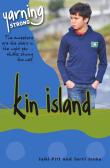 Image courtesy of publisher's website.See full AustLit entry
Image courtesy of publisher's website.See full AustLit entry'Jake’s more interested in video games than in his family background. Visiting the Torres Strait Islands changes all that. He even braves a cyclone to help his Nanna.' (Source: Publishers website)
(...more) -
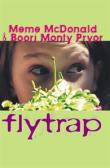 Cover image courtesy the publisher.See full AustLit entry
Cover image courtesy the publisher.See full AustLit entry'Nancy is worried. She's said she has a Venus Flytrap, but she hasn't really got one, and now the teacher wants her to bring it in to show the class. Nancy wants so much to be the centre of attention at school that she makes up a story - a wish, really. At home Nancy is grabbing stories out of the air. Maybe the flytrap ate so many blowflies it got sick? But with the help of stories from both sides of her family - white Australian and Aboriginal - she learns something about what is true for her, and what she herself has to offer.
(...more) -
There is a strong tradition of life writing in Aboriginal and Torres Strait Islander publishing. See more than 1,300 works listed in BlackWords here.
-
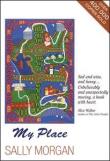 Cover image courtesy of the publisher.See full AustLit entry
Cover image courtesy of the publisher.See full AustLit entry'In 1982, Sally Morgan travelled back to her grandmother's birthplace. What started as a tentative search for information about her family, turned into an overwhelming emotional and spiritual pilgrimage. My Place is a moving account of a search for truth into which a whole family is gradually drawn, finally freeing the tongues of the author's mother and grandmother, allowing them to tell their own stories.' Source: Publisher's blurb.
(...more) -
 Courtesy of UQP'Wayne Coolwell, ABC television and radio presenter, travels throughout Australia and the world to interview twelve Aborigines about their lives. These twelve express their individual sense of Aboriginality and the discovery of spirituality, their ambitions, and their diverse hopes for the future of Australia.' Source: Libraries Australia (Sighted 13/12/07) (...more)See full AustLit entry
Courtesy of UQP'Wayne Coolwell, ABC television and radio presenter, travels throughout Australia and the world to interview twelve Aborigines about their lives. These twelve express their individual sense of Aboriginality and the discovery of spirituality, their ambitions, and their diverse hopes for the future of Australia.' Source: Libraries Australia (Sighted 13/12/07) (...more)See full AustLit entry -
-
 Image courtesy of publisher's website.See full AustLit entry
Image courtesy of publisher's website.See full AustLit entry'The remarkable life story of a leading Aboriginal community activist who grew up in a camp in northern NSW, and worked on health, education and other social issues across the state.
"And I said that to this old fella to this old fella at the ticket box: I want you to come and fix this. Take these ropes off! What do you think we are? Our money is as good as anyone else's and we want to sit where we want to sit. I kept standing there in front of the ticket office, and by then my sister-in-law was there too.
(...more) -
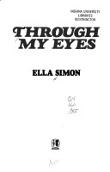 Cover image from Google BooksSee full AustLit entry
Cover image from Google BooksSee full AustLit entry'Born of an Aboriginal mother, and a white father, Ella was raised by her Aboriginal grandparents. Her grandmother, Kundaibark was a Christian and through her Ella grew up a Christian. In the year of her birth, Ella's grandfather moved his family, together with several other Aboriginal families from the crowded and depressed fringe camp at Taree to a new site further out of town. They constructed their own homes, and a UAM missionary was appointed to work there. A church and school were built, the beginnings of the Purfleet Mission.
(...more) -
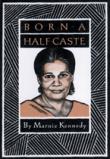 Image courtesy of Publisher websiteSee full AustLit entry
Image courtesy of Publisher websiteSee full AustLit entry'Marnie Kennedy's story begins with her birth in 1919 on the banks of Coppermine Creek in Western Queensland. She tells of her journey to Palm Island where she grew up 'under the act' which dominated the lives of Aboriginal people in Queensland.
The book includes descriptions of Kennedy's hard working life on the cattle stations throughout the north and the people she encountered there. She wrote her story so that white people would come to know and understand the plight of her people by reading of her own life as a 'half-caste'.
(...more) -
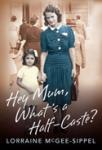 Courtesy of Magabala BooksSee full AustLit entry
Courtesy of Magabala BooksSee full AustLit entry'Lorraine McGee-Sippel was just a small girl when she asked her parents what a half-caste was. It was the 1950s and the first step on a journey that would span decades and lead her to search for her birth family.
'In the historic climate of the Rudd Government's Apology, McGee-Sippel aligns herself with the Stolen Generations as she reveals the far-reaching effects of a government policy that saw her adoptive parents being told their daughter was of Afro-American descent.
'This is not just a story of displacement, but an honest telling that explores the fragility of reconnection, cultural identity, and the triumphs of acceptance.
(...more) -
 Image courtesy of publisher's website.See full AustLit entry
Image courtesy of publisher's website.See full AustLit entry'Don’t Take Your Love to Town is a story of courage in the face of poverty and tragedy. Ruby recounts losing her mother when she was six, growing up in a mission in northern New South Wales and leaving home when she was fifteen. She lived in tin huts and tents in the bush and picked up work on the land while raising nine children virtually single-handedly. Later she struggled to make ends meet in the Koori areas of Sydney. Ruby is an amazing woman whose sense of humour has endured through all the hardships she has experienced.
(...more) -
 Image courtesy of UQPSee full AustLit entry
Image courtesy of UQPSee full AustLit entry'When Ruby Langford Ginibi was eight years old, her father collected his daughters from the Box Ridge mission and drove them to safety out of reach of the white authorities and the policy of removing Aboriginal children from their families. Today an established author and Aboriginal activist, Ruby travels back to her home in Bundjalung country to trace and record the history of her community, her roots. The reader is taken aboard on the journey home, down the backroads of northern New South Wales into the homes and conversations of cousins, aunties, and tribal elders.
(...more) -
 Image courtesy of UQPSee full AustLit entry
Image courtesy of UQPSee full AustLit entry'This absorbing and personal account of Wik activist Jean George Awumpun offers a rare understanding of Aboriginal identity and traditional land. To illustrate her proud Alngith Wikwaya beginnings, Awumpun's early history is told through family member and Alngith descendant Fiona Doyle. This ancestral history combines with the story of Awumpun's struggle in the Wik native title claims, which advanced the earlier Mabo Decision onto mainland Australia.
(...more)The life story was also adapted to a play and performed by the Kooemba Jdarra Indigenous Performing Arts at the Performance Space, Judith Wright Centre of Contemporary Arts, Fortitude Valley, Brisbane, 13 - 24 November 2007. See the AustLit record.
-
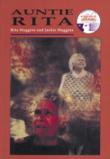 Cover image courtesy the publisher.See full AustLit entry
Cover image courtesy the publisher.See full AustLit entry"Most people call me Auntie Rita, whites as well as Aboriginal people. Auntie is a term of respect of our older women folk. You don't have to be blood-related or anything. Everyone is kin. That's a beautiful thing because in this way no one is ever truly alone, they always have someone they can turn to."
Rita Huggins told her memories to her daughter Jackie, and some of their conversation is in this book. We witness their intimacy, their similarities and their differences, the '"fighting with their tongues".
(...more) -
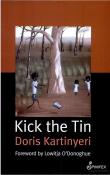 Cover image from Google BooksSee full AustLit entry
Cover image from Google BooksSee full AustLit entry'When Doris Kartinyeri was a month old, her mother died. The family gathered to mourn their loss and welcome the new baby home. But Doris never arrived to live with her family - she was stolen from the hospital and placed in Colebrook Home, where she stayed for the next fourteen years.
The legacy of being a member of the Stolen Generations continued for Doris as she was placed in white homes as a virtual slave, struggled through relationships and suffered with anxiety and mental illness.
(...more) -
An autobiographical essay published in The Weekend Australian 24-25 February 2001.
-
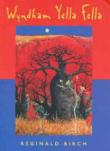 Cover image from Google Books'Reginald Birch remembers his years growing up in the town of Wyndham on the far north-western coast of Australia. Brilliantly captured are the many bittersweet experiences of his family, such as fleeing the Forrest River Mission to escape the threat of a WWII Japanese invasion, and travelling the vast Kimberley landscape in search of work and a place to settle.' Source: Publisher's blurb (...more)See full AustLit entry
Cover image from Google Books'Reginald Birch remembers his years growing up in the town of Wyndham on the far north-western coast of Australia. Brilliantly captured are the many bittersweet experiences of his family, such as fleeing the Forrest River Mission to escape the threat of a WWII Japanese invasion, and travelling the vast Kimberley landscape in search of work and a place to settle.' Source: Publisher's blurb (...more)See full AustLit entry -
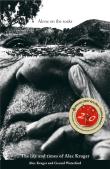 Cover image courtesy of the publisher.See full AustLit entry
Cover image courtesy of the publisher.See full AustLit entry'Alec Kruger was stolen as a child from his family and his country. From this early time he knew the cold and harsh reality of institutions and not the caressing love of his mother or the warmth of other close relations. Still young, he was taken again - to the cattle stations of Central Australia where, even as a boy, he was expected to display all the independence and ingenuity of someone much older. In isolation. Alec faced possible death, till the arrival of Old People from country who saved him, taught him and made him culturally strong.
(...more) -
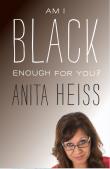 This image has been sourced from Anita Heiss 2014.See full AustLit entry
This image has been sourced from Anita Heiss 2014.See full AustLit entry'I'm Aboriginal. I'm just not the Aboriginal person a lot of people want or expect me to be.
'What does it mean to be Aboriginal? Why is Australia so obsessed with notions of identity? Anita Heiss, successful author and passionate campaigner for Aboriginal literacy, was born a member of the Wiradjuri nation of central New South Wales, but was raised in the suburbs of Sydney and educated at the local Catholic school. She is Aboriginal - however, this does not mean she likes to go barefoot and, please, don't ask her to camp in the desert.
(...more) -
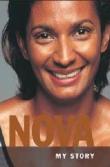 This image has been sourced from online.See full AustLit entry
This image has been sourced from online.See full AustLit entry'The extraordinary life story of a woman who is not only an outstanding athlete but a committed and articulate advocate for Aboriginal rights.
(...more)
'Nova Peris's first memory is of Cyclone Tracy, and her life has been stormy ever since. A child of the stolen generations, she began carving out her own path from the time she was eighteen, when she went to Perth as a single mother with a two-year-old daughter, determined to become a champion athlete.
'She is the first track and field athlete to win international gold medals in two different sports; first in the 1996 Atlanta Olympics as a member of the Australian women's hockey team, and then in the 200 m and 4 x 100 m in the 1998 Commonwealth Games. -
See full AustLit entry
Brief autobiographical statements by well-known black Australian writers, transcribed and edited from interviews. Also includes short extracts from their literary works.
(...more) -
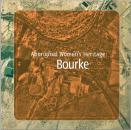 Image Courtesy of Publisher's Website.See full AustLit entry
Image Courtesy of Publisher's Website.See full AustLit entryThe booklets in this series were produced by the Department of Environment and Conservation (DEC). Each booklet describes 'the cultural attachment Aboriginal women have to their local landscape' and in total the booklets record 'the personal stories of 53 Aboriginal women from six NSW regional centres.'
Source: New South Wales National Parks and Wildlife Service website, http://www.nationalparks.nsw.gov.au/npws.nsf/Content/Aboriginal+womens+heritage
(...more)
Sighted: 22/6/2005 -
A collection of life stories from nine Aboriginal women Elders from the Nowra and surrounding regions of southern NSW (...more)See full AustLit entry
-
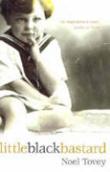 Cover image courtesy ABC Shop.See full AustLit entry
Cover image courtesy ABC Shop.See full AustLit entry'Noel Tovey has an amazing story. A street kid in the slums of Carlton, he survived a childhood - buffeted by the horrors of poverty, sex abuse and neglect - which would have killed some, and certainly twisted most beyond hope. This is the story of how he lived and survived the years of childhood and adolescence - and all along the way held on to a sense of hope and optimism which allowed him to realise his potential as a dancer and choreographer in London and the United States.
Little Black Bastard is also a journey back to the Melbourne of the late 1940s and 1950s - and wonderfully evokes the sights and sounds and social mores of the times.
(...more) -
John Ah Kit writes about his Aboriginal and Chinese heritage and his involvement in politics. (...more)See full AustLit entry
-
-
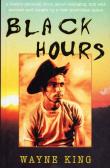 Cover image courtesy of publisher.'Aboriginal and gay, Wayne King felt himself to be an outsider wherever he went in Australia. In Black Hours he tells the powerful and inspirational story of his quest to escape his past and his own sense of isolation.' Source: Publisher's blurb (...more)See full AustLit entry
Cover image courtesy of publisher.'Aboriginal and gay, Wayne King felt himself to be an outsider wherever he went in Australia. In Black Hours he tells the powerful and inspirational story of his quest to escape his past and his own sense of isolation.' Source: Publisher's blurb (...more)See full AustLit entry -
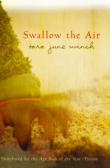 Cover image courtesy UQPSee full AustLit entry
Cover image courtesy UQPSee full AustLit entrySwallow the Air follows the life of 15-year-old May Gibson, an Aboriginal girl from New South Wales whose mother commits suicide. May and her brother go to live with their aunt, but eventually May travels further afield, first to Redfern's Block in Sydney, then to the Northern Territory, and finally into central New South Wales. She travels to escape, but also in pursuit of a sense of her own history, family, and identity.
(...more) -
-
-
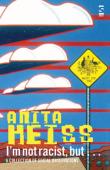 Cover image courtesy the author.I'm Not Racist, but ... is a collection of social observations, thoughts and conversations that will challenge the reader to consider issues of imposed and real Aboriginal identity, the process of reconciliation and issues around saying 'sorry', notions of 'truth' and integrity, biculturalism and invisible whiteness, entrenched racism and political correctness.' Source: Publisher's blurb. (...more)See full AustLit entry
Cover image courtesy the author.I'm Not Racist, but ... is a collection of social observations, thoughts and conversations that will challenge the reader to consider issues of imposed and real Aboriginal identity, the process of reconciliation and issues around saying 'sorry', notions of 'truth' and integrity, biculturalism and invisible whiteness, entrenched racism and political correctness.' Source: Publisher's blurb. (...more)See full AustLit entry -
Published in the Koori Mail, 23 April 1997, this poem speaks of the anguish of dislocation.
-
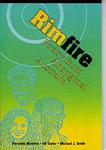 Image courtesy of Magabala Books' Rimfire is the powerful work of three Indigenous poets, who speak of the common experience of Aboriginal people as well as the universal themes of love, life and loss. Rising from the black underbelly of a country that has systematically dispossessed the Indigenous, these poems echo with the call for justice, inclusion and equality.' (Publisher's note, 2000 edition) (...more)See full AustLit entry
Image courtesy of Magabala Books' Rimfire is the powerful work of three Indigenous poets, who speak of the common experience of Aboriginal people as well as the universal themes of love, life and loss. Rising from the black underbelly of a country that has systematically dispossessed the Indigenous, these poems echo with the call for justice, inclusion and equality.' (Publisher's note, 2000 edition) (...more)See full AustLit entry -
-
-
"When I was young they sent me to school"
-
 Image courtesy of UQPSee full AustLit entry
Image courtesy of UQPSee full AustLit entry'My story cannot be painted onto a canvas - it is skin painting.
Brave, haunting and evocative, this powerful volume is poetry as memoir. From her early experiences in an institution and the effect of this on her family to the illustration of her strength as an adult, Elizabeth Hodgson helps make a slice of Aboriginal experience accessible and resonant. Skin Painting explores themes of art, identity, sexuality and loneliness. It is both universal and intimated, honest and important.
(...more) -
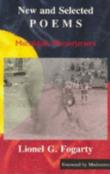 Cover image from Google Books.See full AustLit entry
Cover image from Google Books.See full AustLit entry'... poems are written with directness, honesty and passion. In this book Lionel has combined a selection of poems from previous publications together with several new works.' Source: http://www.kpress.com.au/ (Sighted: 30/06/2009).
(...more) -
-
 Image courtesy of UQP'Winner of the 2005 David Unaipon Award, Anonymous Premonition gives the low-down on what it is to be an Indigenous woman today. Her collection of startling and fresh poems treats us to an energetic and unconventional journey from love, sex, empowerment and travel to motherhood and family, activism and grief.' (Source: Publisher's blurb) (...more)See full AustLit entry
Image courtesy of UQP'Winner of the 2005 David Unaipon Award, Anonymous Premonition gives the low-down on what it is to be an Indigenous woman today. Her collection of startling and fresh poems treats us to an energetic and unconventional journey from love, sex, empowerment and travel to motherhood and family, activism and grief.' (Source: Publisher's blurb) (...more)See full AustLit entry -
 Cover image courtesy the author.'"Bring problems to us before they're too big to handle " the principal advises Zo when she arrives at her new school. But good advice isn't much help to Zo. Her mum's still a workaholic and her best friend is still a thousand miles away back home. Zo soon teams up with fifteen-year-old Missy who is cheeky, smart, a mean soccer player and believes in magic. She's all muscles and attitude like a cattle dog on the warpath. Zo is more laid back - having money makes for a bigger comfort zone even if you are fat and black. (...more)See full AustLit entry
Cover image courtesy the author.'"Bring problems to us before they're too big to handle " the principal advises Zo when she arrives at her new school. But good advice isn't much help to Zo. Her mum's still a workaholic and her best friend is still a thousand miles away back home. Zo soon teams up with fifteen-year-old Missy who is cheeky, smart, a mean soccer player and believes in magic. She's all muscles and attitude like a cattle dog on the warpath. Zo is more laid back - having money makes for a bigger comfort zone even if you are fat and black. (...more)See full AustLit entry -
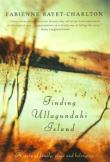 Cover image courtesy the publisher.An autobiographical novel. Through the memories of her much-loved grandmother, Mabel Freeman, Fabienne is looking for her family's untold history and Aboriginality. As a young woman, Mabel Freeman made the journey from the lush green coast to the dry red landscape of Coober Pedy where she lived in a dug-out with her opal-hunting lover, Bruno. The juxtaposition of desert and river highlights the incredible distance, both literally and metaphorically, that Mabel, and in turn Fabienne, travelled from their land and culture. (...more)See full AustLit entry
Cover image courtesy the publisher.An autobiographical novel. Through the memories of her much-loved grandmother, Mabel Freeman, Fabienne is looking for her family's untold history and Aboriginality. As a young woman, Mabel Freeman made the journey from the lush green coast to the dry red landscape of Coober Pedy where she lived in a dug-out with her opal-hunting lover, Bruno. The juxtaposition of desert and river highlights the incredible distance, both literally and metaphorically, that Mabel, and in turn Fabienne, travelled from their land and culture. (...more)See full AustLit entry -
 Cover image courtesy of publisher.Central Australia 1960's ... Ruby lives on a cattle station and goes to the 'silver bullet' school, where she comes across Mr Duncan, her teacher. Ruby begins to question his unusual ways, and in doing so, awakens to her past and the differences between the two cultures and why they are at odds. (...more)See full AustLit entry
Cover image courtesy of publisher.Central Australia 1960's ... Ruby lives on a cattle station and goes to the 'silver bullet' school, where she comes across Mr Duncan, her teacher. Ruby begins to question his unusual ways, and in doing so, awakens to her past and the differences between the two cultures and why they are at odds. (...more)See full AustLit entry -
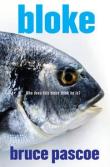 Image courtesy of publisher's website.See full AustLit entry
Image courtesy of publisher's website.See full AustLit entry'Jim Bloke's your typical Aussie, sort of. Being an orphan he's done it tough in the past, but he knows how to take care of himself and he has an affinity with life's important things. So when he takes a job as a sea-urchin diver on a stretch of coastal paradise, he's right at home with the morwong, pearl perch and butterfish.
He's less at home with the people - apart from the woman who works as his deckhand - since the industry's crookeder than your average banker. And because Bloke's already done a season in the big gym, he makes a perfect fall guy when things go wrong.
(...more) -
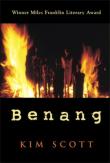 Cover image courtesy the publisher.'Oceanic in its rhythms and understanding, brilliant in its use of language and image, moving in its largeness of spirit, compelling in its narrative scope and style, Benang is a novel of celebration and lament, of beginning and return, of obliteration and recovery, of silencing and of powerful utterance. Both tentative and daring, it speaks to the present and a possible future through stories, dreams, rhythms, songs, images and documents mobilised from the incompletely acknowledged and still dynamic past. (...more)See full AustLit entry
Cover image courtesy the publisher.'Oceanic in its rhythms and understanding, brilliant in its use of language and image, moving in its largeness of spirit, compelling in its narrative scope and style, Benang is a novel of celebration and lament, of beginning and return, of obliteration and recovery, of silencing and of powerful utterance. Both tentative and daring, it speaks to the present and a possible future through stories, dreams, rhythms, songs, images and documents mobilised from the incompletely acknowledged and still dynamic past. (...more)See full AustLit entry -
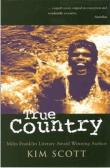 This image has been sourced from Anita Heiss 2014.'Billy is drifting, looking for a place to land. A young school teacher, he arrives in Australia's remote far north in search of his own history, his Aboriginality, and his future. He finds himself in a region of abundance and beauty but also of conflict, dispossession and dislocation. On the desperate frontier between cultures, Billy must find his place of belonging.' (Source: Fremantle Press website) (...more)See full AustLit entry
This image has been sourced from Anita Heiss 2014.'Billy is drifting, looking for a place to land. A young school teacher, he arrives in Australia's remote far north in search of his own history, his Aboriginality, and his future. He finds himself in a region of abundance and beauty but also of conflict, dispossession and dislocation. On the desperate frontier between cultures, Billy must find his place of belonging.' (Source: Fremantle Press website) (...more)See full AustLit entry -
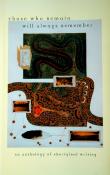 Cover image courtesy of Womens Studies at UNSWSee full AustLit entry
Cover image courtesy of Womens Studies at UNSWSee full AustLit entry'Culture and identity, suffering and the triumph of survival thread their way through the short stories, poems, legends, song lyrics, essays and commentaries in this... anthology of Aboriginal writing.
Representing a range of regional and cultural differences, age groups and social circumstances, it is a testimony to the importance of the past in the construction of a better future.' Source: Publisher's blurb
(...more) -
'"Solid is the story of two very different Aboriginal people who meet on the road to Fitzroy Crossing. Sprung from the 1997 Festival of the Dreaming, "Solid" is an exuberant comedy/drama that explores the tensions and contrasts between city and bush, north and south, traditional and modern blackfella culture.' - Source: http://www.theatre.asn.au/ (Sighted: 30/06/09) (...more)See full AustLit entry
Useful for??
-
'Follows the taunts and temptations of a school girl, and her personal struggle to remain true to her culture and herself.' Source: Publisher's blurb (...more)See full AustLit entry
-
The play deals with a group of young women deciding about their future as they confront issues of Aboriginality, gender and identity. (...more)See full AustLit entry
-
 Image courtesy of publisher's website.See full AustLit entry
Image courtesy of publisher's website.See full AustLit entryWhat do They Call Me? raises questions regarding both lesbian and Aboriginal identity. The three monologues which comprise the play are intricately interwoven and each presents a different view on the impact of legislation from the 1940s through to the 1970s.
Although thrown into jail, Connie Brumbie is at least allowed her Aboriginality. On the other hand, Connie's daughter Regina has been denied knowledge of her true racial background. Having uncovered the fiction of her Eurasian heritage, Regina spends ten years trying to come to terms with her blackness.
(...more) -
See full AustLit entry
'Ruby's Story is a passionate and emotionally moving concert about stolen children and stolen water, sung and recounted by Ngarrindjeri woman Ruby Hunter and her partner in music and life, Archie Roach (Yorta Yorta).
The much loved and respected Ruby and Archie, both members of the Stolen Generation, are accompanied by Paul Grabowsky and the Australian Art Orchestra in this truly unique performance. The concert recounts Ruby's birth by the side of a billabong near the banks of the Murray River in SA.
(...more) -
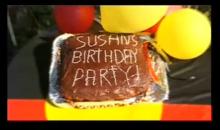 Still from YouTube videoSee full AustLit entry
Still from YouTube videoSee full AustLit entrySusan is an Aboriginal girl with red curly hair and fair skin. She shows her Aboriginal story books, clap sticks and boomerangs to the class at school for show and tell. The other children don't believe she is Aboriginal until they are invited to her birthday party. Back at school after the party there is a common resolve to explore identity and harmony.
The story is told as a short video and is available on YouTube here.
(...more) -
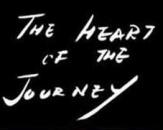 Screen shot from website.See full AustLit entry
Screen shot from website.See full AustLit entryThe Heart of the Journey is a multimedia sound and slide show of over three hundred fifty still photographs with digitally recorded and mixed interviews and music as well as a live performance component. The show moves in a linear fashion telling the true story of Lucy Dann's personal journey. Source: The Heart of the Journey website (Sighted 9 June 2009)
(...more) -
Camping Out is a short film about a sister, two brothers and a girlfriend. It's a comical look at the diversity of the siblings and their understanding of Aboriginality. It showcases the beauty of Wreck Bay Aboriginal Commmunity on the NSW South Coast. (...more)See full AustLit entry
-
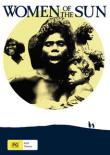 Image from Wikimedia CommonsSee full AustLit entry
Image from Wikimedia CommonsSee full AustLit entryA ground-breaking television series, Women of the Sun was, according to Moran in his Guide to Australian TV Series, born out of co-writer Sonia Borg's desire for a more balanced televisual representation of Indigenous Australians: 'Angry at the plight of Aborigines, she was concerned that many scriptwriters could conceive of Aboriginal women only as prostitutes.' To counter this tendency, she contemplated a series that showed Australian history from the perspective of Aboriginal women, a project for which she sought the colloboration of sociologist and social worker Hyllus Maris.
(...more)Women of the Sun has been a television series, a novel, and a screenplay. See the related AustLit work records.
-
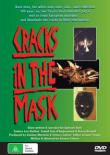 poster imageSee full AustLit entry
poster imageSee full AustLit entry'Over the last 100 years, the Torres Strait Islanders in far north Australia have been the subject of many anthropological expeditions. The resulting depletion of their cultural artefacts has left them with nothing but a history of remembered loss. The only people in the Pacific to make elaborate turtleshell masks have none left; all their material culture now resides in foreign museums.
'In a quest to reclaim the past, Ephraim Bani, a wise and knowledgeable Torres Strait Islander, travels with his wife to the great museums of Europe where his heritage lies.
(...more) -
See full AustLit entry
'B.L.A.C.K. is a cypher scribed by independent and indigenous Hip Hop artist, Wire MC, which stands for Born Long Ago Creation's Keeper. Through interview and observation the song is visually and dialectically deconstructed to speak of contemporary issues around Aboriginal blackness, politics and culture. The filmmaker with his own roots in hip hop aligns himself with Wire and through a rapped narrative adds antoher layer of complexity to notions of blackness, by pulling apart his own identity.
(...more) -
'A fast paced, satirical look at beach access, rites of passage and ownership from the perspective of an Aboriginal and mischievously spirited surfer.' Source: www.afc.gov.au (Sighted 13/09/2007). (...more)See full AustLit entry
-
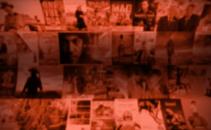 This image has been sourced from Screen AustraliaSee full AustLit entry
This image has been sourced from Screen AustraliaSee full AustLit entry'A Sister's Love is an observational, reflective documentary featuring Rhoda Roberts, best known as an Australian arts presenter and journalist. But behind her smile lies the tragedy of family turmoil, bigotry and the brutal murder of her identical twin sister.
We accompany Rhoda on a road trip home to Lismore in northern NSW to confront the terrible events surrounding the death of her twin sister, Lois, who disappeared while hitchhiking in 1998. Although the local police refused even to file a missing persons report because they assumed she had "just gone walkabout", Lois's brutally murdered remains were found in an isolated part of her Bundjalung homeland some time afterwards.
(...more) -
See full AustLit entry
‘This article might come as a surprise to some, but to many of my colleagues, both Black and white, who know me more intimately, the following is a brief synopsis of my construction of Aboriginality in response to Bain Attwood's 'Portrait of an Aboriginal as an Artist: Sally Morgan and the Construction of Aboriginality'.’ (Opening lines.)
(...more) -
Epigraph: I am black of skin among whites,/ And I am proud,/ Proud of race and proud of skin. - Kath Walker (Oodgeroo Noonuccal)
-
-
'Explores the relationship of Aboriginal poetry with the Aboriginal political voice'. ( Meanjin) (...more)See full AustLit entry
-
-
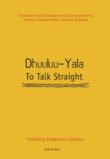 Cover image courtesy the publisher.This work discusses the history of defining Aboriginality in Australia and the experience of being Aboriginal. Both these factors have impacted on the production of Aboriginal writing within the wider context of Indigenous writing. The author also focuses on Indigenous publishing in other countries and how best to market and publish Aboriginal literature. (...more)See full AustLit entry
Cover image courtesy the publisher.This work discusses the history of defining Aboriginality in Australia and the experience of being Aboriginal. Both these factors have impacted on the production of Aboriginal writing within the wider context of Indigenous writing. The author also focuses on Indigenous publishing in other countries and how best to market and publish Aboriginal literature. (...more)See full AustLit entry -
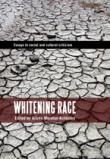 Image Courtesy of Publisher's Website.'With its focus on Australia, Whitening Race enagages with relations between migration, Indigenous dispossession and whiteness. It creates a new intellectual space that investigates the nature of racialised conditions and their role in reproducing colonising relations in Australia.' Back cover of Whitening Race (2004) (...more)See full AustLit entry
Image Courtesy of Publisher's Website.'With its focus on Australia, Whitening Race enagages with relations between migration, Indigenous dispossession and whiteness. It creates a new intellectual space that investigates the nature of racialised conditions and their role in reproducing colonising relations in Australia.' Back cover of Whitening Race (2004) (...more)See full AustLit entry -
-
See full AustLit entry
'Ray Cotti was born to Aboriginal parents but adopted at a young age by a Swiss German family in Sydney. Growing up in a European culture, he thought of himself as white. Then at the age of eight, Ray was removed from his adoptive family and, after living in a series of institutions, placed in foster care. By the time he was in his teens, confusion about his identity was taking a devastating toll. This is a portrait of a young man on a journey of self-discovery, searching for his origins. Now an active member of an Indigenous community with a family of his own, he has found a sense of belonging.
(...more)
You might be interested in...




